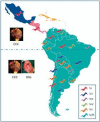Trypanosoma cruzi genetic diversity: impact on transmission cycles and Chagas disease
- PMID: 35544857
- PMCID: PMC9088421
- DOI: 10.1590/0074-02760210193
Trypanosoma cruzi genetic diversity: impact on transmission cycles and Chagas disease
Abstract
Trypanosoma cruzi, the agent of Chagas disease (ChD), exhibits remarkable biological and genetic diversity, along with eco-epidemiological complexity. In order to facilitate communication among researchers aiming at the characterisation of biological and epidemiological aspects of T. cruzi, parasite isolates and strains were partitioned into seven discrete typing units (DTUs), TcI-TcVI and TcBat, identifiable by reproducible genotyping protocols. Here we present the potential origin of the genetic diversity of T. cruzi and summarise knowledge about eco-epidemiological associations of DTUs with mammalian reservoirs and vectors. Circumstantial evidence of a connection between T. cruzi genotype and ChD manifestations is also discussed emphasising the role of the host's immune response in clinical ChD progression. We describe genomic aspects of DTUs focusing on polymorphisms in multigene families encoding surface antigens that play essential functions for parasite survival both in the insect vector and the mammalian host. Such antigens most probably contributed to the parasite success in establishing infections in different hosts and exploring several niches. Gaps in the current knowledge and challenges for future research are pointed out.
Figures




Similar articles
-
Fifteen Years after the Definition of Trypanosoma cruzi DTUs: What Have We Learned?Life (Basel). 2023 Dec 14;13(12):2339. doi: 10.3390/life13122339. Life (Basel). 2023. PMID: 38137940 Free PMC article. Review.
-
Trypanosoma cruzi genetic diversity: Something new for something known about Chagas disease manifestations, serodiagnosis and drug sensitivity.Acta Trop. 2018 Aug;184:38-52. doi: 10.1016/j.actatropica.2017.09.017. Epub 2017 Sep 21. Acta Trop. 2018. PMID: 28941731 Review.
-
Interactions Between Trypanosoma cruzi the Chagas Disease Parasite and Naturally Infected Wild Mepraia Vectors of Chile.Vector Borne Zoonotic Dis. 2016 Mar;16(3):165-71. doi: 10.1089/vbz.2015.1850. Epub 2016 Jan 15. Vector Borne Zoonotic Dis. 2016. PMID: 26771702
-
Molecular identification and genotyping of Trypanosoma cruzi DNA in autochthonous Chagas disease patients from Texas, USA.Infect Genet Evol. 2017 Apr;49:151-156. doi: 10.1016/j.meegid.2017.01.016. Epub 2017 Jan 15. Infect Genet Evol. 2017. PMID: 28095298
-
Repertoire, genealogy and genomic organization of cruzipain and homologous genes in Trypanosoma cruzi, T. cruzi-like and other trypanosome species.PLoS One. 2012;7(6):e38385. doi: 10.1371/journal.pone.0038385. Epub 2012 Jun 7. PLoS One. 2012. PMID: 22685565 Free PMC article.
Cited by
-
Differential Regulation of L-Arginine Metabolism through NOS2 and Arginases during Infection with Trypanosoma cruzi.Pathogens. 2024 Oct 8;13(10):878. doi: 10.3390/pathogens13100878. Pathogens. 2024. PMID: 39452749 Free PMC article.
-
Non-human primates as indicators of Kinetoplastida diversity in an urban environment in Midwest Brazil.Front Parasitol. 2025 Feb 17;4:1547701. doi: 10.3389/fpara.2025.1547701. eCollection 2025. Front Parasitol. 2025. PMID: 40034868 Free PMC article.
-
Trypanosoma cruzi/Triatomine Interactions-A Review.Pathogens. 2025 Apr 17;14(4):392. doi: 10.3390/pathogens14040392. Pathogens. 2025. PMID: 40333244 Free PMC article. Review.
-
Fifteen Years after the Definition of Trypanosoma cruzi DTUs: What Have We Learned?Life (Basel). 2023 Dec 14;13(12):2339. doi: 10.3390/life13122339. Life (Basel). 2023. PMID: 38137940 Free PMC article. Review.
-
Outcomes of patients in Chagas disease of the central nervous system: a systematic review.Parasitology. 2024 Jan;151(1):15-23. doi: 10.1017/S0031182023001117. Epub 2023 Nov 21. Parasitology. 2024. PMID: 37987164 Free PMC article.
References
-
- Stevens JR, Noyes HA, Dover GA, Gibson WC. The ancient and divergent origins of the human pathogenic trypanosomes, Trypanosoma brucei and T cruzi. Parasitology. 1999;118:107–116. - PubMed
-
- Hamilton PB, Teixeira MMG, Stevens JR. The evolution of Trypanosoma cruzi the 'bat seeding' hypothesis. Trends Parasitol. 2012;28:136–141. - PubMed
MeSH terms
LinkOut - more resources
Full Text Sources
Medical

